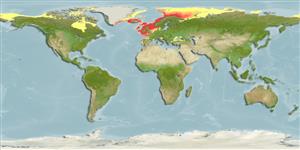Common names from other countries
Classification / Names / Names
Populärnamn | synonymer | Catalog of Fishes (gen., sp.) | ITIS | CoL | WoRMS
Environment: milieu / climate zone / depth range / distribution range
Ekologi
; djupintervall 15 - 535 m (Ref. 119523). Temperate; 82°N - 41°N, 37°W - 158°E
Arctic, Northeast Atlantic and the Mediterranean: Ireland and Germany. Temperate to polar.
Length at first maturity / Size / Vikt / Age
Maturity: Lm ? range ? - ? cm
Known from infralittoral zones (Ref. 85338). Generally inhabits muddy substrates associated with organic pollutants but also present in sandbanks. A microvore that feeds on organic detritus as well as a carnivore-scavenger (Ref. 96352).
Life cycle and mating behavior
Könsmognad | Reproduktion | Lek | Ägg | Fecundity | Larver
Members of the class Anthozoa are either gonochoric or hermaphroditic. Mature gametes are shed into the coelenteron and spawned through the mouth. Life cycle: The zygote develops into a planktonic planula larva. Metamorphosis begins with early morphogenesis of tentacles, septa and pharynx before larval settlement on the aboral end.
Harms, J. 1993. (Ref. 2711)
IUCN Red List Status (Ref. 130435)
CITES status (Ref. 108899)
Not Evaluated
Not Evaluated
Human uses
| FishSource |
Verktyg
Ytterligare information
Age/Size
Tillväxt
Length-weight
Length-length
Morfologi
Larver
Abundans
Internet-källor
Estimates based on models
Preferred temperature
(Ref.
115969): 6.6 - 11.8, mean 8.9 (based on 434 cells).
Price category
Unknown.
